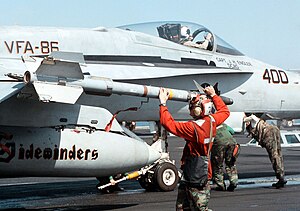AIM-9X Sidewinder
| AIM-9 Sidewinder | |
|---|---|

An AIM-9 Sidewinder is affixed to a U.S. Navy F/A-18 Hornet on board the USS George Washington (CVN-73), February 1998
|
|
| Type | Short-range air-to-air missile |
| Place of origin | United States |
| Service history | |
| In service | 1956–present |
| Production history | |
| Manufacturer |
Raytheon Company Ford Aerospace Loral Corp. |
| Unit cost | US$603,817 (AIM-9X Blk II FY15) |
| Produced | September 1953 |
| Specifications | |
| Weight | 188 pounds (85.3 kg) |
| Length | 9 feet 11 inches (3.02 m) |
| Diameter | 5 in (127.0 mm) |
| Warhead | WDU-17/B annular blast-frag |
| Warhead weight | 20.8 lb (9.4 kg) |
|
Detonation
mechanism |
IR proximity fuse |
|
|
|
| Engine | Hercules/Bermite MK 36 Solid-fuel rocket |
| Wingspan | 11 in (279.4 mm) |
|
Operational
range |
0.6 to 22 miles (1.0 to 35.4 km) |
| Speed | Mach 2.5+ |
|
Guidance
system |
Infrared homing (most models) semi-active radar homing (AIM-9C) |
|
Launch
platform |
Aircraft |
The AIM-9 Sidewinder is a short-range air-to-air missile developed by the United States Navy in the 1950s. Entering service in 1956, variants and upgrades remain in active service with many air forces after six decades. The United States Air Force purchased the Sidewinder after the missile was developed by the United States Navy at China Lake, California. It is one of the most widely used missiles in the world: The AIM-9 is equipping most western-aligned air forces, as well as indirectly many nations which received the Soviet K-13 missile, a reverse-engineered copy of the AIM-9.
The majority of Sidewinder variants utilize infrared homing for guidance; the AIM-9C variant used semi-active radar homing and served as the basis of the AGM-122 Sidearm anti-radar missile. The Sidewinder is the most widely used missile in the West, with more than 110,000 missiles produced for the U.S. and 27 other nations, of which perhaps one percent have been used in combat. It has been built under license by some other nations including Sweden. The AIM-9 is one of the oldest, least expensive, and most successful air-to-air missiles, with an estimated 270 aircraft kills in its history of use. When firing a Sidewinder, American and NATO pilots use the brevity code FOX-2. In addition to fixed-wing aircraft, some modern helicopters, such as the AH-1 SuperCobra, can be equipped with the Sidewinder.
The missile was designed to be simple to upgrade. The United States Navy hosted a 50th anniversary celebration of its existence in 2002. Boeing won a contract in March 2010 to support Sidewinder operations through to 2055, guaranteeing that the weapons system will remain in operation until at least that date. Air Force Spokeswoman Stephanie Powell noted that due to its relative low cost, versatility, and reliability it is "very possible that the Sidewinder will remain in Air Force inventories through the late 21st century".
...
Wikipedia
